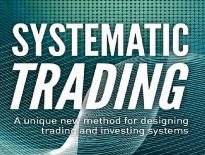Systematic Trading 3 – Frameworks and Forecasts

Today’s post is our third visit to Robert Carver’s book Systematic Trading.
Contents
Modular framework
In Chapter five of his book, Rob describes his framework for a trading system.
He begins by looking at a “bad” trading rule:
- Buy when the 20MA rises above the 40MA, sell (short) when the 40MA falls through the 20MA
- Exit on the reverse of the event that got you to enter
- Don’t trade more than 10 €$ futures, 1 FTSE contract or £10 per spread bet point
- Don’t risk more than 3% of your capital on a single trade
- Set a trailing stop to close when you have lost 3%
- If stops get hit frequently, then widen them
Rob has lots of questions, mostly about the 3% risk measure/stop-loss:
- What if I am a particularly conservative investor or like to hold more than 33 positions at once?
- What if I want to use a slow trading rule (that will generate fewer signals)?
- What about portfolio size, or the current volatility of the market I am trading?
Small accounts held by risk-averse investors would end up setting very tight stops and triggering them a lot.
Rob’s modular approach is to separate trading rules (with stop losses) from position sizing, and both from volatility targeting (cash at risk each day).
- Trading rules and stop losses are based on market volatility, not your account size.
- Whereas your volatility target depends on your account size and your pain threshold.
Rob lists the benefits of his approach as:
- flexibility
- transparency
- well defined interfaces between components, supporting substitutability
- does the boring bit (everything that isn’t the trading rule) for you
- supports asset allocators and semi-automatic traders as well as real systems traders.
Components
Rob’s system consists of:
- trading rules, and potentially variations on these rules
- instruments through which these rules will be traded (stocks, bonds, futures, ETFs)
- price forecasts for each instrument (created by combining forecasts from each rule variation into a weighted average)
- forecasts may be fixed, discretionary or systematic
- a volatility targeting system to define the average daily loss you are willing to expose yourself to
- a position sizing/instrument weighting process to allocate that risk to positions in each instrument
Instruments
The first thing you need to trade an instrument is access to daily price data.
- This will only be economic for private investors on certain instruments.
- Fundamental trading strategies require other kinds of data.
The instrument also needs to trade in an appropriate size.
- Rob quotes Japanese bond futures (minimum size $1M) as something he would like to trade but can’t.
Rob also likes to understand what makes the price of an instrument move.
- Sounds fair enough, but in practice, this just rules out instruments in which there is some form of market intervention, like the Swiss Franc peg that was pulled in 2015.
He also insists on a certain minimum level of volatility.
- This rule would also have excluded the Swiss Franc while it was pegged.
Low volatility means leverage to achieve a target level of risk/return, and since low volatility can rapidly revert to normal or even high volatility, things can get messy.
- Low vol instruments are also usually more expensive to trade.
Rob likes his portfolio of instruments to be as large and diversified as possible, but there are some constraints – not least the value of your account.
- If you are limited by size, choose the least correlated, most liquid and the cheapest to trade instruments.
Expensive instruments are clearly less suited to strategies which involve faster trading.
- Rob stresses once again that he prefers futures to (expensive) spread bets.
- When you have to trade something expensive, you need to trade it slowly.
Skew can be an issue, but there’s more on this to come later in the book.
- Using a positive skew strategy (like trend following) can offset some of the risks of using negative skew assets.
- he trading system as a whole should not have negative skew.
- Extreme negative skew instruments are usually also very low volatility, and should be excluded for that reason.
Rob prefers exchange-traded assets to over the counter (OTC) ones.
- He prefers derivatives (futures and CFDs) because their built-in leverage makes it easier to reach your volatility target.
- Spread bets are more expensive but have a favourable tax treatment.
Forecasts
Rob uses scaled forecasts, where 0 is the current value, +10 is a regular buy and -10 is a sell (short).
- In extreme situations – when you expect large movements in price – the forecast could range up to +20 or down to -20.
Rob expects larger forecasts to be more profitable and says that scaled forecasts have lower trading costs than binary systems.
Rob uses forecasts that are proportional to expected risk-adjusted returns.
- This allows the same number to be used regardless of account size, risk appetite, instrument, or changes in volatility over time.
So if a 10-year bond returns 2% with an SD of 8%, its risk-adjusted return (SR) is 0.25%.
- For a 2-year bond returning 1% with an SD of 8%, the SR is 0.5%.
- So the system forecast for the 2-year bond would be twice as high.
In effect, Rob is saying that the expected Sharpe ratio is a good forecast for an instrument/trading rule.
- The (positive) SR would correspond to 10 on Rob’s forecast scale.
Rob provides a table explaining why forecasts should be capped at 20.
Capped forecasts support diversification, fit with his Gaussian treatment of limited data, deal with pattern reversals at extremes, and avoid negative skew issues.
- Investors who can’t short will also need to use a floor value of zero (no negative forecasts).
EWMAC trend following
In the next section, Rob introduces a couple of trading rules which he uses in his real-life portfolio.
Rob is a big fan of trend following, because it works, and is easily explained by prospect theory.
- It’s also simple to implement (since it needs only price data) and has a positive skew.
EWMAC stands for Exponentially Weighted Moving Average Crossover.
- You buy when the faster MA is above the slower.
Carry
The carry rule is the opposite of trend-following – you make money when nothing happens.
FX carry is the best-known example:
- You borrow in Yen at 0.5% pa and invest in Australian dollars at 5% to make upwards of 3% pa (assuming the JPY/AUD rate doesn’t move in the opposite direction to compensate).
Essentially, carry is the yield on the asset, minus the cost of borrowing.
- That doesn’t sound immediately attractive to me, since I can’t borrow money particularly cheaply.
In theory, prices should move against the buyer to remove the profits but often they don’t.
- But sometimes they do, leading to sharp losses and negative skew.
That’s another reason for me not to like the rule.
- Rob has a better idea – to combine rules with positive skew with others with a negative skew.
This would promising, but I would need to confirm that the cheap borrowing is provided by the broker (or spread bet provider).
Close to open
This is a rule Rob read about while researching the book, and which he hasn’t personally tested.
- He provides a table showing how he would adapt this rule to fit his framework.
Variations
As previously discussed, when looking at rule variations, Rob focuses on correlations and trading speed.
- He won’t add variations with a correlation greater than 95%, and he doesn’t like things which trade too slowly or quickly (too few or too many signals).
Slow instruments have low Sharpe ratios and fast instruments are expensive to trade.
Combined Forecasts
Rob combines rule forecasts using weighted averages.
- The weights used are called forecast weights.
In a crude oil example, EWMAC had a forecast of +15 in mid-2009, whilst Carry had a forecast of -10.
- Equal weighting these two gives an average of 2.5.
To work out weights in general, Rob uses his hand-crafting method.
- This involves grouping similar assets (rules) on the basis of their correlations.
The simplest method is to group the variations on a single trading rule, then allocate across trading rules.
Rob assumes a scenario where there are three variations of the EWMAC rule, where the fast MA is in turn 16, 32 and 64 days (and the slow MA is 64, 128 and 256 days).
- He calculates (via correlation tables) that the weights should be 42% to the outside variations and 16% to the central one (within the 50% weight to the EWMACS rule – the other 50% goes to the carry rule).
Scaling
As less than perfectly correlated assets/rules are added to the portfolio/set of rules, the volatility will fall.
- This means that the combined forecast is no longer scaled to 10.
Even worse, individual combined forecasts for different instruments will be unpredictably scaled.
Rob fixes this with a diversification multiplier.
- The multiplier is the target volatility of 10%, divided by the combined volatility.
Two assets with 10% volatility and 0.5 correlation would have a portfolio volatility of 8.66% (zero correlation gives 7.07% volatility).
- So 10/8.66 gives a multiplier of 1.15 (10/7.07 gives a multiplier of 1.44).
Negative correlations lead to large multipliers, so Rob recommends a floor of zero for correlations.
- He also provides a table of multipliers, and a table of correlations for the rule variations we looked at earlier.
Since Rob recommends that combined forecasts are capped at 20, he also recommends that the diversification multiplier is capped at 2.5.
Conclusions
It’s been another interesting visit to Rob’s book, but I’m not sure that I’m up to using all of this, at least to begin with.
- In particular, I might skip uneven weightings of rule variations based on correlations, and just weight each variation equally.
I’m also not totally convinced by the Carry rule, or rather it’s implementation (I understand carry as a concept).
- But we’re a long way from implementation at the moment.
In the next part of the book, we’ll look at volatility targeting and position sizing.
- Until next time.














